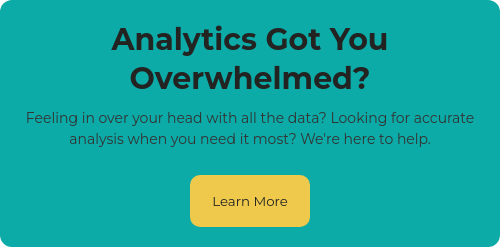Psst! Are you listening? Good, because we’ve got something important to talk about, and it might just change your brand for the better. Social listening is a must-have strategy for brands in 2020, and if you haven’t created or implemented one yet, now is the time.
Understanding social listening, and the ways it can inform your predictive analytics strategy, will help you forecast buyer behavior and strengthen your brand. The latest data shows that 49 percent of the world’s population uses social media on a regular basis, making it one of the best tools for reaching your audience. But if you’ve been thinking of social media as a megaphone, blaring out your message for the masses, you’re on the wrong track. Instead, think of it as a telephone: a two-way conversation between your brand and your audience. How do you use that conversation to make better marketing decisions? That’s where social listening comes in.
What is Social Listening?
Let’s say you post a clever but slightly controversial meme to your brand’s Facebook page. After a few hours, you check the numbers. Engagements are skyrocketing! Success! Or is it? If 90 percent of that engagement is coming in the form of angry face emojis, you’ve got a problem. Social listening is about more than numbers: it utilizes a combination of data, behavior tracking and consumer insight to build an actionable plan that shapes your brand voice and nurtures the conversation between you and your audience.
Social Monitoring vs. Social Listening
You may be wondering how social listening is different from the social tracking you’re already doing. “Social monitoring” is the term used for traditional social analytics, which tells you how many likes you get, how many followers you have, or how your latest post is performing. Social listening deepens the conversation, looking not just at how much your audience is interacting, but what they’re saying… and how they’re saying it. Social listening differs from social monitoring in that it relies on consumer behaviors, brand perception and feelings to inform marketing strategies. Social listening takes the following qualities into account:
-
EMOTION: How do your customers speak about your brand? What feelings does it evoke in them? Do they prefer content that is uplifting and inspiring, or sarcastic and dry? Gauging the emotion that influences your followers will help you craft more engaging messaging, and glean key audience insights.
-
MOOD: What is the general mood of your brand, and how do followers respond to it? The mood you set on social may be different than the mood you promote in more traditional marketing, and it may even vary by platform. Use social listening to determine what brand tone is most effective with each audience segment.
-
SENTIMENT: This is how you measure general audience perception of your brand on social media. Social listening tools can give you the resources to track sentiment and discover if your audience feels positive, negative or neutral toward your brand.
-
ACTION: This is the key difference between social listening and social monitoring. Tracking data is important, but finding effective ways to act on those insights in a way that meaningful and motivational to your audience is the ultimate goal.
Why Should Social Listening Be Part of My Marketing Analytics Strategy?
Social listening gives you more than numbers; it gives you the reason for those numbers, and helps you react in a way that is appropriate, appealing and in alignment with your overall brand. Hopefully, you’ve already incorporated predictive analytics into your metric tracking. If so, you’ll find that the insights you gain from social listening will help you forecast the behavior and decision-making of your social followers, to help you deliver the right message, right where they need it. Here are some of the practical benefits of social listening:
-
Engagement Tracking: Traditional metrics will tell you which posts get the most engagements, but social listening dives deeper, to determine why. Looking for trends in engagement will help you identify the emotions that drive your audience to respond… and those that don’t.
-
Competitive Analysis: Social listening is about more than what your followers are saying about you; it also gives you insight into what they’re saying about your competitors. This will help you see what other brands in your industry are doing right… and what they’re doing wrong.
-
Crisis Management: Get ahead of problems or respond to crises in a timely manner by utilizing social listening to identify issues before they explode into disasters. Your followers may be talking about an impending crisis before you’re aware it’s coming, but with social listening, you can prepare your response and ensure your team stays consistent with messaging and tone.
-
Lead Generation: Focus groups and market research can be costly and time consuming. With social listening, your audience comes to you with valuable insights that will help you craft impactful lead gen strategies. Discover what your audience wants and how they want it delivered, and meet them where they are.
-
Content Creation: Let’s say your brand is a furniture company. Your Pinterest followers want to see home decorating inspo and photos to help them envision your product in their space. Your Instagram followers want the latest info on sales and limited-time deals. On LinkedIn, your followers are mostly industry professionals, suppliers and vendors, and they want to know best practices, industry trends and outlooks. Posting the same generic copy on each platform isn’t going to get you very far, but by tracking, measuring and listening to what each audience is saying, you can create custom content, delivered right where they need it.
How Do I Use Social Listening to Optimize My Analytics?
Social listening will change the way you identify trends and create forecasts for your brand. Now, you’ll find that many social listening tools can be integrated with your predictive analytics platform, or used in conjunction with your marketing data to create actionable insights. But where to begin? Right here:
-
Use the right keywords. Keywords are fundamental to building a social listening strategy. You’ll need to identify exactly how your audience is talking about your brand, but you can start with a general list that includes your brand name, product names (along with common misspellings), frequently used hashtags and competitor brands.
-
Design a strategy for each platform. As mentioned above, you’ll want content that gets to the heart of your audience’s needs wherever they happen to be interacting with you. Track behavior on each platform to discern what followers want, and create a plan specific to those followers.
-
Adapt your voice. Once you’ve gleaned the varying behaviors, drivers and emotions of each social segment, you’ll want to make adjustments to your brand tone and voice to suit each one.
-
Figure out what you want. What are your goals in employing a social listening strategy? Perhaps you want to identify influencers or brand advocates. Maybe you want real-time feedback on product launches or an upcoming rebrand. Knowing what you want from the data will help you determine what metrics matter the most, and how you can incorporate them into your analytics strategy.
-
Use the right social listening tools. Social listening software and platforms have come a long way in recent years, and are now widely available, more affordable, and intuitive, even if you aren’t a social listening expert. Here are a few of the top names in the game:
-
HubSpot: As an official HubSpot Agency Partner, we are always pleased to recommend the robust lineup of services they provide. Their social media management software covers everything from scheduling to publishing to listening and insights.
-
Hootsuite: This is one of the big names in social media management, and this all-in-one platform allows you to plan a comprehensive strategy that incorporates social listening, even allowing you to engage with your audience from a single dashboard.
-
Sprout Social: Sprout offers a complete line of social media management tools, with a focus on analytics and data. Reports can be customized by date range and metrics needed, and competitor reports are also available.
-
Awario: This is a relative newcomer to the social listening space, but it offers a specialized and customizable platform at an affordable rate. If you’re just dipping your toe into the waters of social listening, this might be a great entry point.
-
So, now you’re in on the secret: social listening isn’t going away, and it’s key to keeping your brand on top in the social space.







